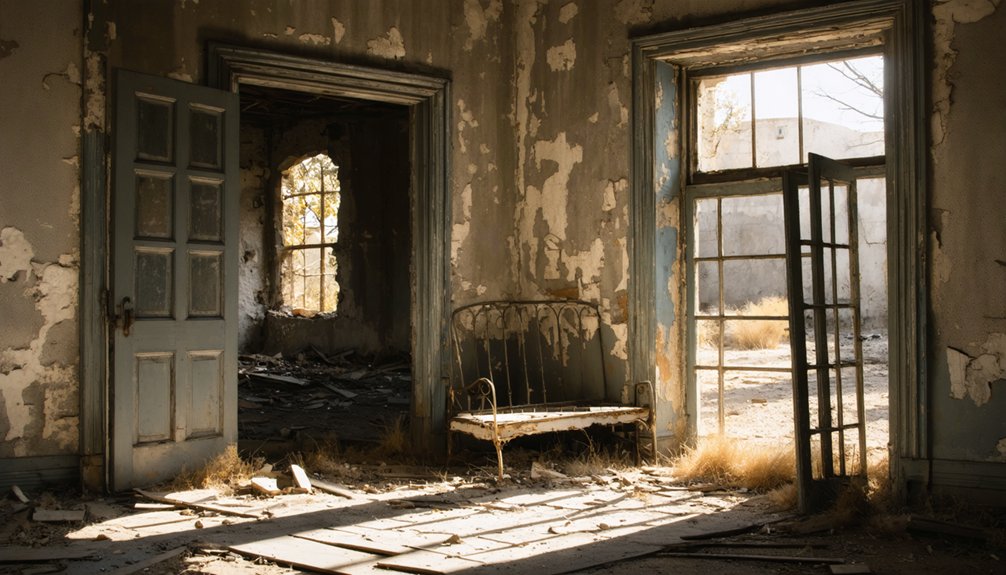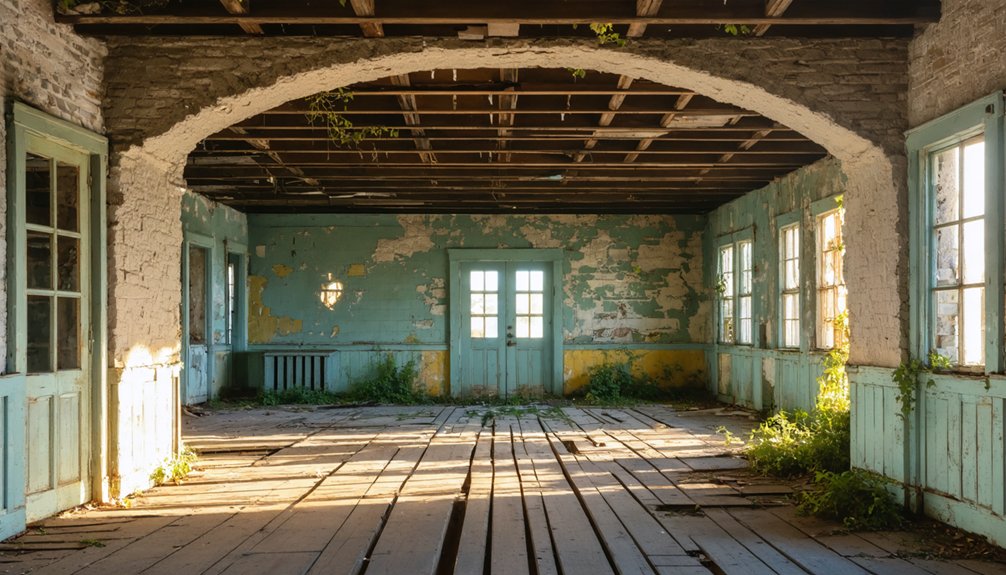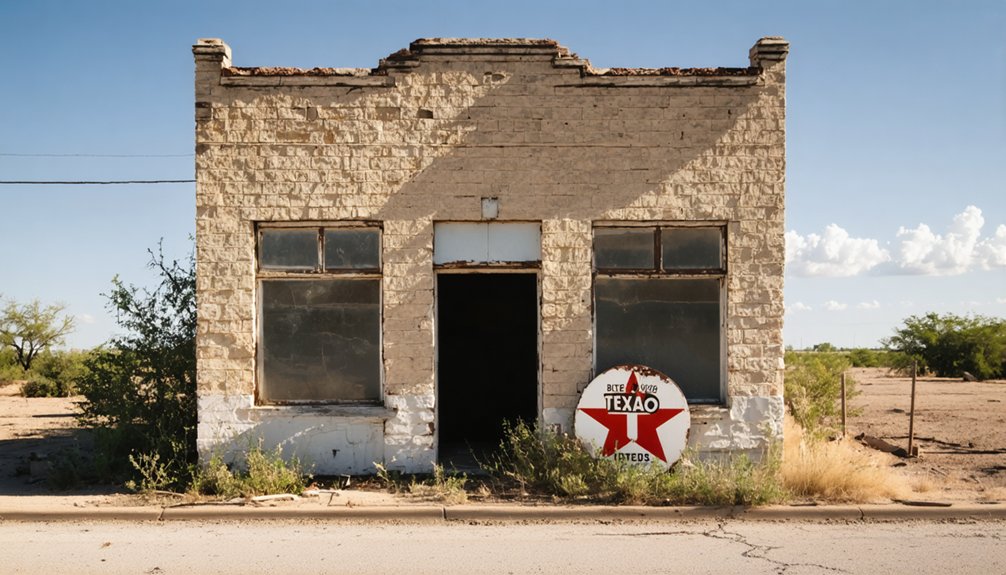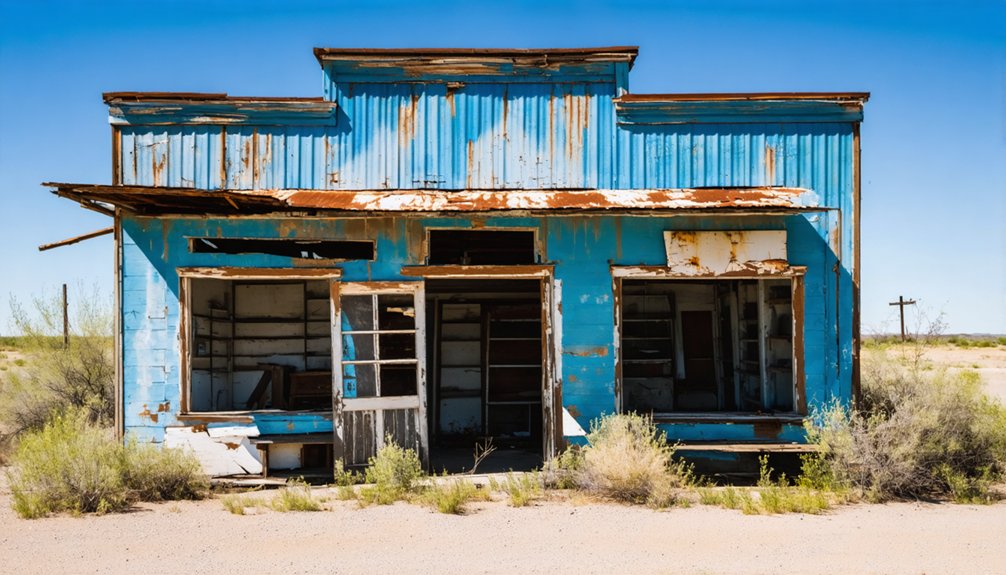You’ll find Catarina’s ghost town ruins in South Texas, where a once-thriving agricultural community of 2,500 residents emerged around artesian wells in the early 1900s. The town boasted paved streets, a grand hotel, and a concrete schoolhouse during its golden age. When the wells dried up between 1929-1931, the population plummeted to 592, leading to widespread abandonment. Today, concrete ruins and overgrown vegetation tell a compelling story of boom-to-bust transformation in early Texas history.
Key Takeaways
- Catarina transformed from a thriving agricultural town of 2,500 residents to a ghost town when artesian wells dried up in the early 1930s.
- The town’s concrete schoolhouse, Palm Suite and Inn ruins remain as prominent architectural relics of its prosperous past.
- Once-bustling streets and farmland have been reclaimed by native wildlife, creating natural habitats for deer, rabbits, and birds.
- The community’s decline began dramatically between 1929-1931, with population dropping from 2,500 to 592 due to water scarcity.
- Originally established as a railroad stop, Catarina flourished through agriculture supported by artesian wells until water resources depleted.
Origins of the Catarina Legend
While the exact origins of Catarina’s name remain debated, historical records trace its usage to at least 1778 when Spanish priest Friar Morfi documented the area during his travels along the Camino Real.
The earliest documentation of Catarina appears in Friar Morfi’s 1778 travel records as he journeyed the historic Camino Real.
The region was known as “Aquaje de Santa Catarina,” referencing an essential water-hole in the harsh South Texas terrain. The establishment of Catarina Station as a railroad stop helped spur the community’s early development.
Local Catarina folklore centers on a Mexican woman who met a tragic end at the hands of Comanche raiders.
You’ll find two main versions of her story – one depicts her as a ranch cook whose ghost still sings on moonlit nights, while another describes her as an early settler killed during indigenous conflicts.
These ghost stories have become deeply woven into the area’s cultural fabric, transforming a historical tragedy into supernatural legend that continues to intrigue visitors today.
The town grew rapidly in the early 1900s, reaching a peak population of 2,500 by 1929 before its eventual decline.
Early Pioneer Settlement Years
When Spanish settlers first established Catarina around 1778 in present-day Dimmit County, they recognized the area’s agricultural potential due to its abundant water sources and fertile soil.
The land, originally owned by David Sinton as part of the Sinton-Taft Ranch, attracted farming families seeking opportunity in the region’s long growing season.
Despite pioneer struggles with geographic isolation, the community’s resilience shone through as engineer Kearney designed a model town with modern amenities.
You’ll find evidence of their ambitious vision in the broad streets, 14-acre park with a concrete swimming pool, and infrastructure supporting up to 10,000 residents.
The construction of the Asherton and Gulf Railway in 1910 marked a pivotal moment in Catarina’s development, connecting the isolated community to broader markets.
The town’s most notable structure was the Taft House, built specifically to accommodate visits from President William Howard Taft.
The Booming Golden Age
Catarina’s golden age saw its population surge to between 1,000 and 2,500 residents by 1929, transforming the settlement into a bustling agricultural hub.
You’d find the town’s success stemmed from its abundant artesian wells, which enabled year-round farming and attracted numerous settlers enthusiastic to capitalize on the fertile land.
The town’s prosperity manifested in impressive infrastructure developments, including paved streets, a grand hotel, a concrete schoolhouse, a bank, multiple grocery stores, and various commercial establishments that served the growing community. The Taft House became a prominent landmark after Charles Taft constructed it in 1915.
The development of the area was further enhanced when the Camino Real passed through the region, establishing crucial transportation routes for the growing community.
Thriving Population and Commerce
Between 1910 and 1929, the tiny settlement of Catarina transformed into a bustling agricultural hub, reaching a peak population of 2,500 residents.
You’d find a thriving community shaped by cultural influences from farmers and merchants who established diverse businesses throughout the town. Similar to semi-abandoned towns like Welfare and Whiteway, Catarina boasted tremendous economic activity during its peak years. The economic shifts brought remarkable growth, with paved streets connecting a grand hotel, two grocery stores, a lumber company, and a bakery.
The town’s prosperity manifested in its civic development, including a concrete schoolhouse and post office that served as essential community centers.
Abundant artesian wells supported a robust agricultural economy, while the commissary and bunkhouse accommodated the workforce.
This golden age showcased Catarina’s rapid evolution from a modest settlement into a significant regional center of commerce and community life. The town’s detailed history required careful disambiguation efforts to distinguish it from other locations sharing the Catarina name.
Water-Fueled Agricultural Success
The accidental discovery of artesian wells during fence post drilling near Catarina sparked an agricultural revolution that would define the town’s golden age.
Through innovative water management systems and agricultural sustainability practices, you’d find farmers transforming the semi-arid landscape into productive farmland. The superior quality of artesian water, combined with modern irrigation methods, enabled the cultivation of diverse crops and supported thriving cattle operations. Agricultural success drove strawberry festivals to become prominent local events. The area saw remarkable growth as land values soared from under $2 to over $40 per acre by 1920.
- The region’s farmers pioneered Bermuda onion cultivation, capitalizing on the long growing season and reliable water supply.
- By 1930, agricultural success drove the population to nearly 1,000 residents.
- The combination of sprinkler irrigation and artesian wells helped farmers maintain productivity even during South Texas’s notorious dry spells.
These advancements established Catarina as a monument to agricultural ingenuity and water resource development.
Impressive Community Infrastructure
During its golden age, you’d find impressive urban planning and development throughout Catarina, where engineer Kearney had designed a model town capable of supporting 10,000 residents.
The community amenities included broad, well-lit paved boulevards, a modern water system with a silo-type tower, and essential utilities like telephone and electricity.
You’d discover a 14-acre park featuring recreational facilities, including a concrete swimming pool and bathhouse.
The town’s infrastructure prioritized safety with a volunteer fire company, equipped with a 1927 Model T Ford fire truck and strategically placed hydrants.
Commercial development thrived with multiple businesses, including a bank, grocery stores, lumber company, and bakery.
The concrete school building and Community Church, established in 1928, served as crucial social anchors, offering educational programs and religious activities.
From Prosperity to Hardship

Prospering through abundant artesian wells and a thriving agricultural economy, Catarina experienced remarkable growth in the early 20th century, reaching a peak population between 1,000 and 2,500 residents by 1929.
The town’s lack of economic diversification, however, left it vulnerable when the Great Depression struck. You’ll find that the community’s resilience was tested as businesses shuttered and families departed, seeking opportunities elsewhere.
- The population plummeted dramatically from 2,500 to just 592 residents between 1929 and 1931
- The once-reliable artesian wells dried up, devastating agricultural operations
- The town’s infrastructure, including the grand hotel and schoolhouse, fell into disrepair as financial hardship forced closures
These challenges marked the beginning of Catarina’s transformation from a bustling town to a ghost town.
Water Crisis and Agricultural Decline
While Catarina’s economic decline during the Great Depression dealt a significant blow to the community, underlying water resource issues would prove even more devastating.
You’ll find that the town’s prosperity initially stemmed from abundant artesian wells that supported thriving agricultural operations. However, by the early 1930s, these crucial water sources dried up, causing irrigation projects to fail and agricultural sustainability to plummet.
The absence of effective water management strategies left farmers unable to maintain crop production throughout the growing season. As both surface water and hand-dug wells proved insufficient to meet the community’s needs, agricultural families were forced to abandon their fields.
This rapid depletion of water resources, combined with broader economic challenges, transformed Catarina from a bustling community of a thousand residents to a fraction of its former size.
Architectural Remnants Today

You’ll find the former Catarina School’s enduring concrete frame stands as one of the most prominent architectural remnants, with its sturdy construction defying decades of abandonment.
The downtown area’s buildings, including the fire-damaged Palm Suite and Inn from 1926, now exist primarily as stone and concrete walls reclaimed by nature.
While most wooden structures have deteriorated completely, the remaining ruins and foundations offer clear evidence of early 1900s Texan construction methods, blending stone, concrete, and traditional building techniques.
Standing School Structure Remnants
The concrete remnants of Catarina’s schoolhouse stand as a tribute to early 20th-century construction durability, with its skeleton framework and foundation remaining largely intact despite decades of abandonment.
The school architecture reflects the utilitarian design common in rural Texas, now weathered but still visible through encroaching vegetation.
You’ll find these historic remains just past the antique store, where dirt roads lead to what was once the heart of this small town‘s educational center.
- The poured concrete walls defy time, preserving the original footprint
- Native plants weave through the structure, creating a haunting blend of civilization and wilderness
- The school’s endurance serves as a powerful community legacy, marking both Catarina’s prosperity and decline
Reclaimed Downtown Buildings
Standing amid scattered ruins and weathered foundations, downtown Catarina’s architectural remnants tell a compelling story of its rise and decline.
Through urban exploration, you’ll discover the haunting shell of the 1926 Palm Suite and Inn, its exterior walls reaching skyward after a mysterious 2020 fire gutted its interior.
You’ll find the reclaimed architecture of the old Commissary Building, its brick foundations and partial walls now embracing wild vegetation.
The bank building’s concrete foundations mark where financial dreams once thrived until the Great Depression.
Near the town center, you can trace the scattered remains of grocery stores and the lumber company, their concrete pads and rubble marking where commerce once flourished in this now-silent Texas town.
Wildlife Reclaiming the Town
Since Catarina’s abandonment, native wildlife has steadily reclaimed the ghost town‘s empty streets and deteriorating structures, transforming the once-bustling settlement into a thriving natural habitat.
You’ll witness remarkable wildlife adaptation as deer traverse dirt roads, rabbits flourish in neglected spaces, and various bird species nest in deteriorating buildings. The absence of human activity has restored ecological balance, allowing native species to expand their territories.
- Ruined concrete foundations now serve as sheltered dens for small mammals and reptiles.
- Overgrown vegetation has created natural corridors for wildlife movement and foraging.
- Former residential lots have become breeding grounds for diverse species, from raptors to rodents.
Despite challenges like limited water sources and occasional human disturbance, Catarina’s rewilding demonstrates nature’s resilience in reclaiming urbanized spaces.
Preserving Local Heritage

While wildlife reclaims Catarina’s physical spaces, dedicated preservation efforts work to protect the town’s historical legacy for future generations.
You’ll find community storytelling at the heart of these initiatives, with local groups collecting oral histories from former residents and promoting cultural preservation through educational outreach programs.
The town’s concrete structures, including the old Catarina School, receive maintenance to prevent total collapse, while historical documents like Friar Morfi’s 1778 diary provide essential research context.
Ongoing structural maintenance of Catarina’s historic buildings, coupled with period documents, helps preserve the town’s rich architectural and cultural legacy.
Despite challenges of limited resources and population decline, you can witness passionate local advocates organizing temporary events that connect former residents with heritage enthusiasts.
They’re preserving business records, photographs, and artifacts while emphasizing the town’s boom-and-bust narrative as a valuable lesson in community planning.
Through these combined efforts, Catarina’s heritage remains alive despite its physical deterioration.
Modern Tourism and Ghost Town Status
Despite its near-abandonment, Catarina endures as a partial ghost town with fewer than 50 residents, a stark contrast to its peak population of over 2,000 in 1929.
You’ll find wildlife reclaiming the deserted streets while concrete ruins of the town’s former glory stand as silent witnesses to history.
Ghost town tourism draws visitors seeking authentic glimpses into Texas’s rural past, though limited infrastructure means you’ll need to navigate dirt roads and bring your own provisions.
For the adventurous explorer, Catarina offers:
- Photographic opportunities of deteriorating historic structures, including hotel foundations and school remains
- Self-guided exploration of a genuine semi-abandoned settlement
- Firsthand experience of nature’s reclamation of human development
Historical documentation of Catarina’s story continues through online media, local blogs, and video features, preserving its legacy for future generations.
Frequently Asked Questions
Are There Any Paranormal Investigations or Ghost Sightings Reported in Catarina?
You won’t find documented ghostly encounters or spectral evidence in Catarina’s records. Unlike other Texas ghost towns, there aren’t any widely reported paranormal investigations or confirmed supernatural sightings here.
What Happened to the Original Residents’ Descendants After Leaving Catarina?
Like a mighty river flowing outward, you’ll find thousands of descendants scattered across South Texas, preserving family legacies through cultural traditions while pursuing diverse careers after historical migrations from their ancestral hometown.
Can Visitors Legally Explore and Photograph the Abandoned Buildings?
You’ll need landowner permission before exploring or photographing abandoned buildings since they’re likely private property. Photography from public roads is allowed, but trespassing for exploration guidelines isn’t legal without explicit consent.
Were Any Movies or Television Shows Ever Filmed in Catarina?
You won’t find any documented Catarina films or Catarina documentaries shot in this ghost town. Unlike other Texas ghost towns that have attracted film crews, there’s no evidence of media productions here.
Does Anyone Maintain Genealogical Records or Photographs of Early Catarina Families?
You’ll find genealogical societies and historical groups maintain some records, while descendants keep family archives. Local museums, county offices, and church records also preserve early Catarina family histories and photographs.
References
- https://www.youtube.com/watch?v=BoQlQniHRNU
- https://www.texasescapes.com/MikeCoxTexasTales/259-Catarina-Texas-Ghost-Town-and-Ghost-Hotel.htm
- http://www.texasescapes.com/SouthTexasTowns/Catarina-Texas.htm
- https://rural-ruin.livejournal.com/771844.html
- https://en.wikipedia.org/wiki/List_of_ghost_towns_in_Texas
- https://www.amli.com/blog/abandoned-ghost-towns-near-austin-texas
- https://thetexasgiftwagon.blogspot.com/2017/12/catarina-texas-little-history-book-i.html
- https://www.sanantoniothingstodo.com/texas-ghost-towns-san-antonio-tx/
- https://www.texasalmanac.com/places/catarina
- https://en.wikipedia.org/wiki/Catarina



